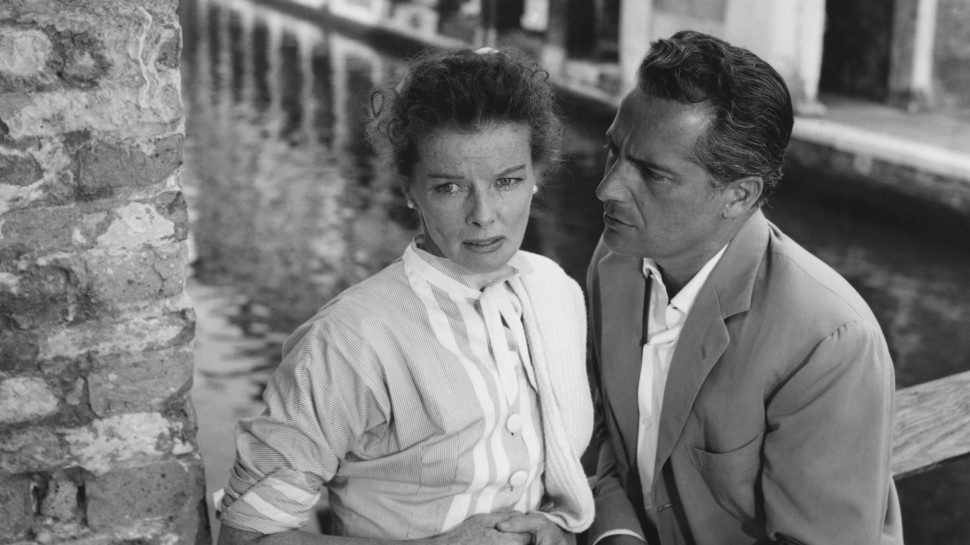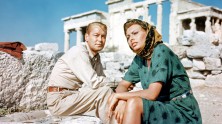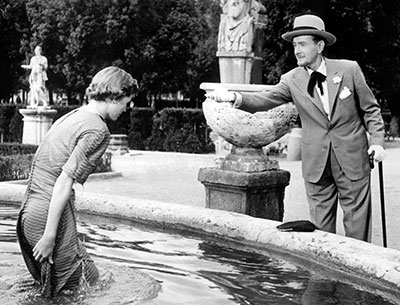
Innocence Abroad
The films in this series are about Americans in Europe in the 1950s, but the Europe on view is not a real or recognizable place. It’s a dreamland, what the historian Wolfgang Schivelbusch calls a “neurotic, hallucinatory fantasy world.” A psychological and cultural response of vanquished nations to the experience of defeat in world war, this dreamland dynamic applies to the victorious imagination as well, as the films in this series demonstrate.
In these films, the primary fantasy on view is one of “pastoralization.” In 1943, at the height of the war, Henry Morgenthau Jr., FDR’s treasury secretary, put forward a proposal for eventual reconstruction, now known as the Morgenthau Plan, that called for the “increased, if not total, pastoralization” of Germany. Purification through pastoralization was a form of denazification and an article of the new faith: faith in democracy. This may not have been a viable foreign policy (it gave way to the Marshall Plan), but it was an awesome and elastic concept that exerted a powerful pull on the postwar American imagination. In American visual culture of the late 1940s and 50s, European nations (not just Germany) were routinely divested of their claims on modernity and technology and returned to pastoral or picturesque states—deindustrialized, demilitarized, scenic landscapes in which a new class of triumphant American tourist and traveler, middle-class and often Midwestern, could indulge in love among the ruins.
This fantasy is especially pronounced in this series’ films about France, which have a storybook quality. In Daddy Long Legs, when the huge American Cadillac carrying a State Department delegation gets stuck in a ditch in the French countryside, Fred Astaire, playing a New World dandy and millionaire bachelor, comes upon an orphanage named "Jean d’Arc" that looks as if its been torn from the pages of a Charles Perrault fairy tale: turreted, crumbling, overgrown with wild weeds, and decorated with fading fleur-de-lys wallpaper. The orphanage is France and all the French are orphans. Charmed by an eighteen-year-old girl named Julie Andre (a nod to Rousseau’s Julie, or the New Heloise), he decides to anonymously sponsor her education at an all-girls New England college, where she will be reeducated in the precepts of American ideals.
In “Bonjour, Paris!”, the musical centerpiece of Funny Face, Paris is a fashion fantasyland where political and religious monuments are drained of their former ideological power and turned into scenic motifs. The Eiffel Tower, originally built for the 1889 Paris Exposition, no longer registers as a monument to the republican ideals of the French Third Republic or French mastery of industry, but now serves, at the song's climax, as a panoramic viewing platform for "The Great American Tourist" ("I'm strictly tourist, but I couldn't care less.") The cheerful troupes of dancing bellhops who welcome the film’s three main characters ("light up the Louvre museum, jazz up the Latin Quarter") are representative of the redemptive pastoral power of American democracy exported abroad in the Marshall Plan.
This political allegory was amplified by new widescreen technologies that literally stretched the possibilities of the medium, not just in these films, but also in Boy on a Dolphin and Three Coins in the Fountain, which take place in Athens and Rome. Funny Face was filmed in VistaVision; Daddy Long Legs, Boy on a Dolphin and Three Coins in the Fountain in Cinemascope. These widescreen technologies provided immersive experiences for American moviegoers, situating them in enchanted foreign landscapes (“entertainment enchantment...enhanced by DeLuxe color"), while simultaneously allowing them to exercise a kind of imperialistic vision—the Cinemascope lens was the eye of American Enterprise, democratizing everything that fell within the vista view: monuments, entire nations, history, humanity itself.
“Heritage can be a shackle to art,” the American secretary Maria instructs an Italian prince in Three Coins in the Fountain. In these films, the Cinemascope lens liberates art from tradition. In Daddy Long Legs, French art is literally set in motion, transformed into a “performing art” in a series of magical ballets (director Jean Negulesco described the film as "happy magic"). European civilization as symbolized by its art, which was defiled by the Nazis, will be purified under the chaste stewardship of the United States—that's the point of the orphan narrative in Daddy Long Legs, as well as the “Villa Eden” in Three Coins in the Fountain where the American secretaries live.
Ruins: In A Foreign Affair, Berlin is a lair of seductive moral ruin and rehabilitation, while in Boy on a Dolphin, a moral battle over the mantle of civilization is waged amid the ruins on the Athenian Acropolis. In Terminal Station, Roman Holiday, Summertime, The Roman Spring of Mrs. Stone and Three Coins in the Fountain, Rome and Venice are ruin-strewn landscapes of mysterious holiday noir and dark erotic escape.
These are Jamesian narratives for the postwar world, in which American naiveté comes into contact (if not exactly conflict) with European decadence and ennui. In the films set in Italy, the political allegory takes a back seat to narratives about subjectivity. American women unfulfilled by notions of stability and respectability, yearning for a deeper, richer, more creative kind of experience, and searching for meaning in a world of expanded horizons, voyage to Italy in order to live for the first time, to learn how to see and to feel to have their illusions about themselves shattered. As in the Jamesian novel, in Terminal Station, Summertime and The Roman Spring of Mrs. Stone—which were written by Truman Capote, Arthur Laurents and Tennessee Williams, respectively—gay male subjectivity and sexual desire are transposed onto “fancy” women.
Some themes to keep in mind: first, the theme of seeing. Characters in these films are constantly depicted in the act of looking, often through photographic devices. In Funny Face, New York is the new world capital of modernity and technology, vis-à-vis Paris, as represented by the vast apparatuses of mechanical reproduction seen in the opening sequences. In Daddy Long Legs, in the film’s climatic ballet sequence, Fred Astaire watches Leslie Caron perform through a pair of binoculars, his own private Cinemascope lens. In Roman Holiday, Gregory Peck’s comic attempt to photograph his romance with Audrey Hepburn becomes a central plot point; he even attempts to wrest a Brownie camera from the neck of a young girl, one of a number of dark moments in an otherwise light tale. In Summertime, we see Katherine Hepburn looking at Venice through her movie camera, and then we see what she’s seeing. These films dramatize the incessant photographic reproduction of the world and circulation of images as leitmotifs of the postwar condition, but they also visualize, in a new way, the ecstasy of seeing and of looking at the world.
Arrivals and departures: In Terminal Station, Summertime and Three Coins in the Fountain, the main characters arrive by train. In Gentleman Prefer Blondes, it’s an ocean liner. In A Foreign Affair and Funny Face, it’s by airplane. Modes of transport in these films are metaphors for the larger experience itself, as the characters are transported to new psychological and cultural planes and levels of existence. The sudden freeze-frame of the train at the start of Terminal Station suggests an arrested consciousness, whereas the slow-moving trains in the opening and closing scenes of Summertime suggest expectation, evolution, and the nature of memory—of all the films, Summertime is the most attentive to memory—the images director David Lean gives us are memory images, perhaps as Hepburn’s character will remember the city once she returns home.
Finally, the theme of belief: In these films, cynicism and irony are either absent or banished. In A Foreign Affair, Marlene Dietrich’s cosmopolitan cynicism is crushed by Jean Arthur’s belief in American goodness. In Funny Face, the French “Empathacalists” are revealed to be cynical frauds, no match for the Quality Magazine editors and “enlighteners.” In Boy on a Dolphin, the selfish and cynical treasure hunter is no match for the American archaeologist, who staunchly defends faith in “good government” as rooted in the proper care and maintenance of Greek antiquities. But belief is registered best, I think, again in Summertime, where Hepburn’s faith in beauty, in love, and in the world itself is reaffirmed by her encounter with Venice and her discovery of her true self.
The United States may emerge in these films as the heir and guardian of the whole body of Western Civilization in the aftermath of the Second World War, but what is ultimately celebrated is the wonder—and innocence—of individual subjective experience. – Jeffrey Lieber, Visiting Assistant Professor, History of Art + Architecture, Harvard













